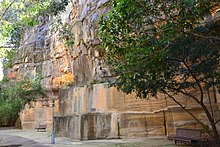
| Hawkesbury Sandstone | |
|---|---|
| Stratigraphic range: | |
| Type | Geological formation |
| Underlies | Ashfield Shale, Wianamatta Shale |
| Overlies | Terrigal Formation, Narrabeen Group, Newport Formation |
| Thickness | up to 290 metres |
| Lithology | |
| Primary | Sandstone |
| Other | Shale |
| Location | |
| Country | |
| Extent | Sydney Basin |


Sydney sandstone, also known as the Hawkesbury sandstone,[1] yellowblock, and yellow gold,[2] is a sedimentary rock named after Sydney, and the Hawkesbury River north of Sydney, where this sandstone is particularly common.[3]
It forms the bedrock for much of the region of Sydney, Australia. Well known for its durable quality, it is the reason many Aboriginal rock carvings and drawings in the area still exist. As a highly favoured building material, especially preferred during the city's early years—from the late 1790s to the 1890s—its use, particularly in public buildings, gives the city its distinctive appearance.
The sandstone is notable for its geological characteristics; its relationship to Sydney's vegetation and topography; the history of the quarries that worked it; and the quality of the buildings and sculptures constructed from it. This bedrock gives the city some of its "personality" by dint of its meteorological, horticultural, aesthetic and historical impact. One author describes Sydney's sandstone as "a kind of base note, an ever-present reminder of its Georgian beginnings and more ancient past."[4]
Sydney sandstone was deposited in the Triassic Period probably in a freshwater delta and is the caprock which controls the erosion and scarp retreat of the Illawarra escarpment.[5][6][7] Sandstone escarpments box in the Sydney area on three sides: to the west the Blue Mountains, and to the north and south, the Hornsby Plateau and Woronora Plateau. These escarpments kept Sydney in its bounds and some people still regard the spatial boundaries of the city in these terms.[8]
- ^ "Hawkesbury Sandstone". Geo Science Australia. Australian Government. Retrieved 18 March 2021.
- ^ "Pyrmont 'yellow gold' breathing new life into Sydney's historic buildings". TWT Property Group. 12 June 2018. Retrieved 7 February 2024.
- ^ Irvine, Jessica (31 July 2015). "Budget cuts to hit Sydney's iconic sandstone buildings". The Sydney Morning Herald. Retrieved 4 September 2017.
- ^ Falconer 2010, p. 3.
- ^ Fairley & Moore 2000, p. 19.
- ^ Branagan & Packham 2000.
- ^ "The Sydney Basin". Australian Museum. 2 June 2009. Retrieved 1 November 2016.
- ^ Karskens 2010, p. 19.